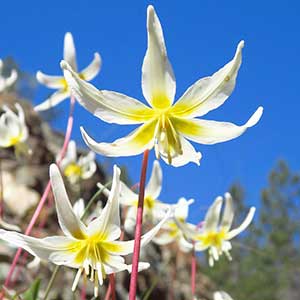Erythronium citrinum
Erythronium albidum
citrus fawn lily, cream fawn lily, lemon color fawn lily, lemon fawn lily, pale fawn-lily
white fawnlily, white trout-lily
slender, 40–50 mm, sometimes producing sessile offsets.
ovoid, 15–30 mm;
stolons 1–3, mostly on 1-leaved, nonflowering plants; flowering plants reproducing vegetatively by offshoots or droppers.
9–15 cm;
blade mottled with irregular streaks of brown or white, lanceolate to narrowly ovate, margins ± wavy.
8–22 cm;
blade green, irregularly mottled, elliptic-lanceolate to ovate-lanceolate or elliptic, ± flat, glaucous, margins entire.
12–35 cm.
7–20 cm.
1–3-flowered.
1-flowered.
tepals ± white, often pinkish, usually pale yellow at base, lanceolate to narrowly elliptic, 25–45 mm, inner with or without small auricles at base;
stamens 11–17 mm;
filaments linear, white or pinkish, slender, less than 0.8 mm wide;
anthers white, cream, pink, reddish, or brownish red;
style straight, white or pink, 6–10 mm;
stigma unlobed or with lobes shorter than 1 mm.
tepals strongly reflexed at anthesis, white, tinged pink, blue, or lavender abaxially, with yellow adaxial spot at base, lanceolate, 22–40 mm, auricles absent;
stamens 10–20 mm;
filaments yellow, lanceolate;
anthers yellow;
pollen yellow;
style white, 15–25 mm;
stigma lobes recurving, 1.5 mm.
obovoid, 2–5 cm.
held erect at maturity, obovoid, 10–22 mm, apex rounded to faintly apiculate or umbilicate.
= 24.
= 44.
Erythronium citrinum
Erythronium albidum
Plants lacking auricles on inner tepals are sometimes segregated as Erythronium howellii, Howell’s fawn-lily, but they do not appear to differ from typical E. citrinum in any other characters. Erythronium citrinum intergrades with E. californicum and E. hendersonii, occasional populations or individuals displaying intermediate or recombined characteristics. Such plants from the upper Scott River drainage in Trinity County, California, which may be the result of introgression with E. hendersonii, have been recognized as variety roderickii.
(Discussion copyrighted by Flora of North America; reprinted with permission.)
Erythronium albidum often forms extensive colonies in which nonflowering, 1-leaved plants far outnumber flowering, 2-leaved ones. It is very widespread in eastern North America, more common in the central states than E. americanum and often occurs in slightly drier sites.
(Discussion copyrighted by Flora of North America; reprinted with permission.)
